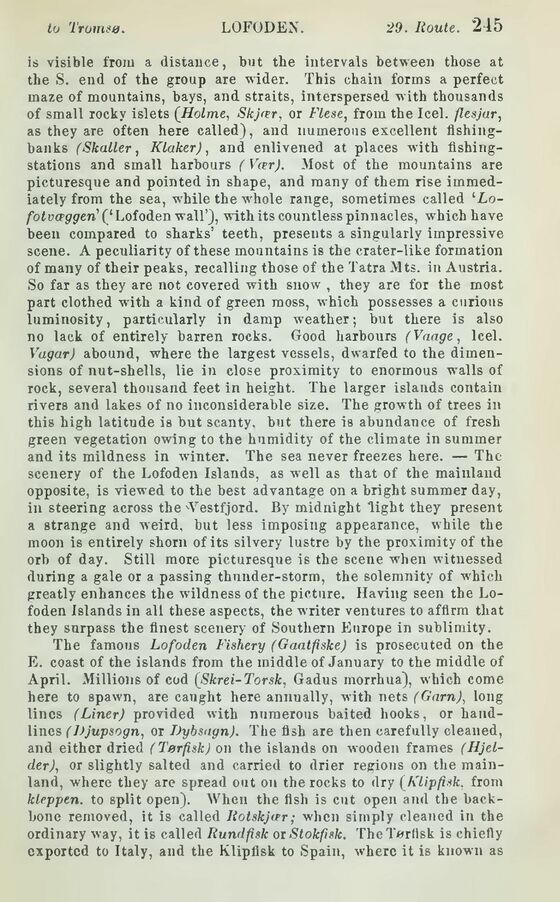
Full resolution (JPEG) - On this page / på denna sida - Norway - Pages ...

<< prev. page << föreg. sida << >> nästa sida >> next page >>
Below is the raw OCR text
from the above scanned image.
Do you see an error? Proofread the page now!
Här nedan syns maskintolkade texten från faksimilbilden ovan.
Ser du något fel? Korrekturläs sidan nu!
This page has never been proofread. / Denna sida har aldrig korrekturlästs.
is visible from a distance, but the intervals between those at
the S. end of the group are wider. This chain forms a perfect
maze of mountains, bays, and straits, interspersed with thousands
of small rocky islets {Holme, Skjrer, or Flese, from the Icel. flesjar,
as they are often here called), and numerous excellent
fishing-banks (Skaller, Klaker), and enlivened at places with
fishing-stations and small harbours (Vær). Most of the mountains are
picturesque and pointed in shape, and many of them rise
immediately from the sea, while the whole range, sometimes called
‘Lo-fotvæggen’ (‘Lofoden wall’), with its countless pinnacles, which have
been compared to sharks’ teeth, presents a singularly impressive
scene. A peculiarity of these mountains is the crater-like formation
of many of their peaks, recalling those of the Tatra Mts. in Austria.
So far as they are not covered with snow , they are for the most
part clothed with a kind of green moss, which possesses a curious
luminosity, particularly in damp weather; but there is also
no lack of entirely barren rocks. Good harbours (Vaage, lcel.
Vagar) abound, where the largest vessels, dwarfed to the
dimensions of nut-shells, lie in close proximity to enormous walls of
rock, several thousand feet in height. The larger islands contain
rivers and lakes of no inconsiderable size. The growth of trees in
this high latitude is but scanty, but there is abundance of fresh
green vegetation owing to the humidity of the climate in summer
and its mildness in winter. The sea never freezes here. — The
scenery of the Lofoden Islands, as well as that of the mainland
opposite, is viewed to the best advantage on a bright summer day,
in steering across the ’Vestfjord. By midnight “light they present
a strange and weird, but less imposing appearance, while the
moon is entirely shorn of its silvery lustre by the proximity of the
orb of day. Still more picturesque is the scene when witnessed
during a gale or a passing thunder-storm, the solemnity of which
greatly enhances the wildness of the picture. Having seen the
Lofoden Islands in all these aspects, the writer ventures to affirm that
they surpass the finest scenery of Southern Europe in sublimity.
The famous Lofoden Fishery (Goatfiske) is prosecuted on the
E. coast of the islands from the middle of January to the middle of
April. Millions of cod {Skrei-Torsk, Gadus morrhua), which come
here to spawn, are caught here annually, with nets (Gam), long
lines (Liner) provided with numerous baited hooks, or
handlines (l)jupsogn, or Dybsagn). The fish are then carefully cleaned,
and either dried (Tørfisk) on the islands on wooden frames
(Hjel-der), or slightly salted and carried to drier regions on the
mainland, where they are spread out on the rocks to dry (Klipfisk, from
kleppen, to split open). When the fish is cut open and the
backbone removed, it is called Rotskjær; when simply cleaned in the
ordinary way, it is called Rundfisk or Stokfisk. TheTørfisk is chiefly
exported to Italy, and the Klipfisk to Spain, where it is known as
<< prev. page << föreg. sida << >> nästa sida >> next page >>